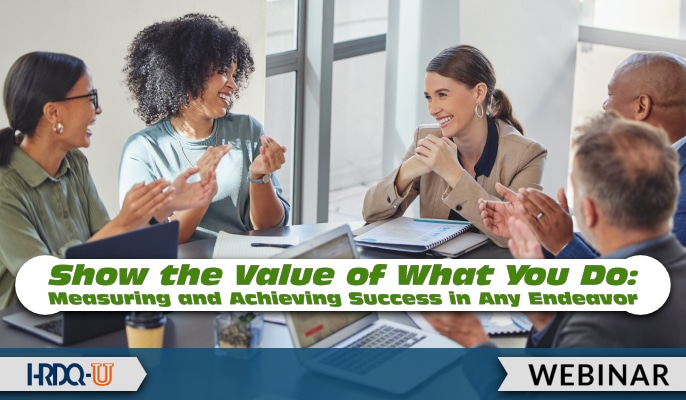
Inflation is up, unemployment is down, the stock market is volatile, and how we work has forever changed. But one thing that remains the same is the need to show the value of what you do. In fact, given today’s flexible work environment and uncertainty in the economy, showing the value of our work has never been more critical or necessary. The good news is that it is doable, regardless of your role or the projects for which you are responsible. Hear from Jack and Patti Phillips, co-founders of ROI Institute, as they share the process described in their new book, Show the Value of What You Do: How to Measure and Achieve Success in Any Endeavor. This event offers you the opportunity to learn about the six-step Show the Value process that is designed to support individuals who need to show the value of not only major projects but also their day-to-day work.
This presentation features stories describing how people use the process to demonstrate the value of their work. Participants who attend this session will receive a copy of the presentation and job aids to support their work. Jack and Patti will also share details on how you can receive a free copy of Show the Value of What You Do: Measuring and Achieving Success in Any Endeavor!
Jack J. Phillips, Ph.D., chairman of ROI Institute, Inc., is a world-renowned expert on accountability, measurement, and evaluation. He provides consulting services for Fortune 500 companies, nonprofit entities, and government and non-governmental organizations globally. He is the author or editor of more than 100 books, conducts workshops, and presents at conferences worldwide.
Jack has received several awards for his books and work. The American Society for Training and Development gave him its highest honor, Distinguished Contribution to Workplace Learning and Development. The International Society for Performance Improvement presented Jack with its highest award, the Thomas F. Gilbert Award, for his contribution to human performance technology. On three occasions, Meeting News named him one of the 25 Most Powerful People in the Meetings and Events Industry, based on his work on ROI. The Society for Human Resource Management presented him with an award for one of his books and honored a Phillips ROI study with its highest award for creativity. In 2019, Jack, along with his wife Patti P. Phillips, received the Distinguished Contributor Award from the Center for Talent Reporting for their contribution to the measurement and management of human capital. His work has been featured in the Wall Street Journal, BusinessWeek, and Fortune. He has been interviewed by several television programs, including CNN.
Jack regularly consults with clients in manufacturing, service, and government organizations in 70 countries around the world.
Connect with Jack on Facebook, Twitter, and at www.roiinstitute.net.
Patti P. Phillips, Ph.D., CEO of ROI Institute, Inc., is a renowned leader in measurement and evaluation. Patti helps organizations implement the ROI Methodology®️ in more than 70 countries around the world. Since 1997, Patti has been a driving force in the global adoption of the ROI Methodology and the use of measurement and evaluation to drive organizational change. Her work as an educator, researcher, consultant, and coach supports practitioners as they develop their own expertise in an effort to help organizations and communities thrive. Her work spans private sector, public sector, nonprofit, and nongovernmental organizations.
Patti serves as a member of the Board of Trustees of the United Nations Institute for Training and Research (UNITAR). She serves as chair of the Institute for Corporate Productivity (i4cp) People Analytics Board, Principal Research Fellow for The Conference Board, board chair of the Center for Talent Reporting (CTR); and is an Association for Talent Development (ATD) Certification Institute Fellow. She also serves on the faculty of the UN System Staff College in Turin, Italy. Patti has authored or edited more than 75 books on the subject of measurement, evaluation, analytics, and ROI. Her work has been featured on CNBC, Euronews, and in more than a dozen business journals.
Connect with Patti on Facebook, Twitter, and at www.roiinstitute.net.
Training Tools for Developing Great People Skills
This event is sponsored by HRDQ. For 45 years HRDQ has provided research-based, off-the-shelf soft-skills training resources for classroom, virtual, and online training. From assessments and workshops to experiential hands-on games, HRDQ helps organizations improve performance, increase job satisfaction, and more.
Learn more at HRDQstore.com
“I received tangible resources that I can apply to my work immediately – thank you!”
– Mandi B.
“The webinar is great. Very informative, timely, and relevant. Looking forward to attending more webinars to come. Thanks.”
– Luzviminda D.
“The information was very relevant for my job and I can apply a lot of what I learned today. Thanks!”
– Soeli E.

Sign up for more as a member of HRDQ-U
HRDQ-U offers much of its learning content free to visitors, including live and select webinars, blog posts, and more, with new events and posts shared every week. However, there is much more learning available. You can access our complete library of on-demand webinars and other training events and content by simply signing up.